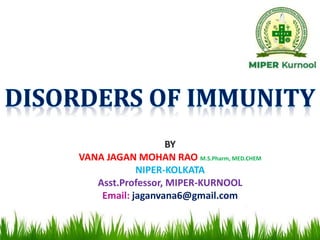
Disorders of immunity
- 1. BY VANA JAGAN MOHAN RAO M.S.Pharm, MED.CHEM NIPER-KOLKATA Asst.Professor, MIPER-KURNOOL Email: jaganvana6@gmail.com
- 2. IMMUNOPATHOLOGY • Allergy, hypersensitivity – an exaggerated, misdirected expression of immune responses • Involves the same types of immune reactions as those at work in protective immunities. • Autoimmunity – abnormal responses to self Ag • Immunodeficiency – deficiency or loss of immunity • Cancer – results from a lack of surveillance 2
- 3. 3
- 4. 4
- 5. Type I Hypersensitivity 5 • Atopy – any chronic local allergy such as hay fever or asthma • Anaphylaxis – a systemic, often explosive reaction that involves airway obstruction and circulatory collapse
- 6. Mechanism of Type I 6 • sensitizing dose – on first contact with allergen, specific B cells form IgE which attaches to mast cells and basophils • provocative dose - subsequent exposure with the same allergen binds to the IgE-mast cell complex • degranulation releases mediators with physiological effects such as vasodilation and bronchoconstriction • symptoms are rash, itching, redness, increased mucous discharge, pain, swelling, and difficulty breathing
- 7. 8
- 8. Role of Mast Cells & Basophils 8 • Mast cells are located in the connective tissue of virtually all organs; high conc. in lungs, skin, GI and genital tract • Basophils circulate in blood, migrate into tissues • each cell can bind 10,000-40,000 IgE • cytoplasmic granules contain physiologically active cytokines, histamine, etc • cells degranulate when stimulated by allergen
- 10. Systemic Anaphylaxis 10 • Sudden respiratory and circulatory disruption that can be fatal in a few minutes • Allergen and route are variable • Bee stings, antibiotics or serum injection
- 11. 11 Strategies for circumventing allergic attacks
- 12. 12 Blocking Ab
- 13. Type II Hypersensitivity 13 • Reactions that lyse foreign cells • Involve antibodies, complement, leading to lysis of foreign cells • Transfusion reactions – ABO blood groups – Rh factor – hemolytic disease of the newborn
- 14. 14
- 15. 15
- 16. 16
- 17. 17
- 18. Type III Hypersensitivity 18 • A large quantity of soluble foreign Ag stimulates Ab that produce small, soluble Ag-Ab complexes • Immune complexes become trapped in tissues & incite a damaging inflammatory response – Arthus reaction – local reaction to series of injected Ag to same body site – Serum sickness – systemic disease resulting from repeated injections of foreign proteins
- 19. 19
- 20. 20 Autoimmunity • In certain type I & II hypersensitivities, the immune system has lost tolerance to self molecules and forms autoantibodies and sensitized T cells against them. • More common in females • Disruption of function can be systemic or organic specific – Systemic lupus erythematosus – Rheumatoid arthritis – Endocrine autoimmunities – Myasthenia gravis – Multiple sclerosis
- 21. 21
- 22. 22
- 23. 23
- 24. 24
- 25. Type IV Hypersensitivity 25 • Cell-mediated • A delayed response to Ag involving activation of and damage by T cells • Delayed allergic response – skin response to allergens – tuberculin skin test, contact dermititis from plants, metals, cosmetics • Graft rejection – reaction of cytotoxic T cells directed against foreign cells of a grafted tissue; involves recognition of foreign HLA
- 26. 26
- 27. 27
- 28. 28
- 29. Immunodeficiency diseases • Components of the immune response system are absent. Deficiencies involve B and T cells, phagocytes, and complement – Primary immunodeficiency – genetically based congenital lack of B-cell and/or T cell activity – B cell defect – agammaglobulinemia – patient lacks antibodies – T cell defect – thymus is missing or abnormal – Severe combined immunodeficiency - both limbs of lymphocyte system are missing or defective; no adaptive immune response – Secondary (acquired) immune deficiency – due to damage after birth (infections, drugs, radiation) AIDS 29
- 30. 30
- 31. Cancer 31 • Overgrowth of abnormal tissue arises due to malfunction of immune surveillance • Tumors may be benign (nonspreading) or malignant (a cancer) that spreads from tissue of origin to other sites • Malignant tumors may be – carcinomas originate from epithelial tissue – sarcomas originate from embryonic connective tissue • Cancers occur in nearly every cell type
- 32. Characteristics of cancerous growths 32 • Disorganized behavior and independence from surrounding normal tissues • Permanent loss of cell differentiation • Expression of special markers on their surface
- 33. Interrelationship between genes and cancer 33 1. Cancer cell often have damaged chromosomes 2. A specific alteration in a gene can lead to cancer 3. Predisposition for some cancers is inherited 4. Rates of cancer are highest in individuals who cannot repair damaged DNA 5. Mutagenic agents cause cancer 6. Cells contain genes that can be transformed to cancer-causing oncogenes 7. Tumor-supressor genes exist in the normal genome
- 34. Mechanism of Cancer 34 • Some type of gene alteration turns a normal gene (proto-oncogene) that regulates the onset of mitosis into an oncogene • The oncogene overrides normal mitotic controls and cause the cell to divide continuously • Tumor suppressor genes may be missing or inactivated
- 35. 35
- 36. Role of viruses in cancer 36 • Some viruses carry oncogenes whose products cause transformation of host cells into cancer cells • Viral genome may be inserted into regulatory sites • Human papillomavirus cervical cancer • Epstein-Barr virus – Burkitt’s lymphoma
- 37. 37
- 38. 38
- 39. Function of immune system in cancer 39 • Cells with cancer-causing potential arise constantly in the body but the immune system normally discovers and destroys them • Cell-mediated immunity, TC, NK & macrophages, antibodies • Immune system fails in cancer – may not be immunogenic enough – may retain self-markers and not be targeted • Maybe a slight or transient failure allows cancer to develop
